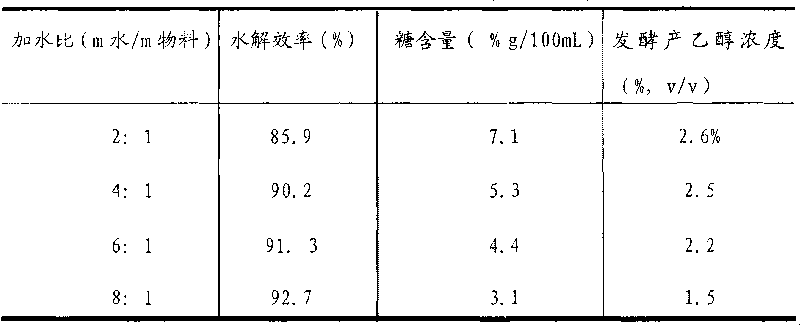Pretreatment method for biorefinery of lignocellulose
A technology of lignocellulose and biorefining, applied in fiber raw material processing, textiles and papermaking, etc., can solve the problems of not meeting the requirements of ecological environment, affecting the effect of cellulose hydrolysis, serious environmental pollution, etc., achieving low cost and improving efficiency , The effect of simple process
- Summary
- Abstract
- Description
- Claims
- Application Information
AI Technical Summary
Problems solved by technology
Method used
Image
Examples
Embodiment 1
[0051] Dry 1 kg of wheat straw, clean the soil, crush it to a particle size of 80-100 mesh, add 7 kg of water to make a slurry, put it into a pressure vessel for a catalytic hydrolysis reaction, and control the reaction temperature at 140 ° C. for 50 minutes. The reacted material is filtered and dried, and the filtrate is collected. After the filtrate is concentrated, it is used for fermenting ethanol or preparing five-carbon sugar, and the recovery rate of the five-carbon sugar is 91.3%. After the solid part after a catalytic hydrolysis reaction is dried, add 45g of calcium carbonate, feed oxygen or air, control the pressure at 15 atmospheres, and treat it for 30 minutes under the action of steam at 150°C, release the pressure quickly, and collect the slurry. The reacted material is filtered, and the liquid after alcohol washing is distilled under reduced pressure to recover ethanol. The filtered liquid part adjusts the pH to below 7, collects the solid after precipitation, ...
Embodiment 2
[0053] Dry 1 kg of rice stalks in the air, wash the soil, crush until the particle size is 50 mesh, add 8 kg of water to make a slurry, and put it into a pressure vessel for a catalytic hydrolysis reaction. The reaction temperature is controlled at 160°C and the reaction time is 60 minutes. . The reacted material is filtered and dried, and the filtrate is collected. After the filtrate is concentrated, it is used for fermenting ethanol or preparing five-carbon sugar, and the recovery rate of the five-carbon sugar is 92.1%. After the solid part after a catalytic hydrolysis reaction was dried, 72g of lithium carbonate was added, oxygen was introduced, the pressure was controlled at 8 atmospheres, and under the action of steam at 140°C, it was treated for 70 minutes, and the pressure was released quickly to collect the slurry. The reacted material is filtered, and the liquid after alcohol washing is distilled under reduced pressure to recover ethanol. The filtered liquid part adj...
Embodiment 3
[0055] Dry 1 kg of pine wood chips, clean the soil, crush until the particle size is 90 mesh, add 7 kg of water to make a slurry, and put it into a pressure vessel for a catalytic hydrolysis reaction. The reaction temperature is controlled at 170 ° C and the reaction time is 70 minutes. . The reacted material is filtered and dried, and the liquid is collected and concentrated for use in fermenting ethanol or preparing five-carbon sugar, and the recovery rate of the five-carbon sugar is 93.5%. After the solid part after a catalytic hydrolysis reaction was dried, 55g of sodium carbonate was added, oxygen was introduced, the pressure was controlled at 10 atmospheres, and under the action of steam at 160°C, it was treated for 40 minutes, and the pressure was released quickly to collect the slurry. The reacted material is filtered, and the liquid after alcohol washing is distilled under reduced pressure to recover ethanol. The filtered liquid part adjusts the pH to below 3, collec...
PUM
| Property | Measurement | Unit |
|---|---|---|
| Granularity | aaaaa | aaaaa |
| Granularity | aaaaa | aaaaa |
Abstract
Description
Claims
Application Information
 Login to View More
Login to View More - R&D
- Intellectual Property
- Life Sciences
- Materials
- Tech Scout
- Unparalleled Data Quality
- Higher Quality Content
- 60% Fewer Hallucinations
Browse by: Latest US Patents, China's latest patents, Technical Efficacy Thesaurus, Application Domain, Technology Topic, Popular Technical Reports.
© 2025 PatSnap. All rights reserved.Legal|Privacy policy|Modern Slavery Act Transparency Statement|Sitemap|About US| Contact US: help@patsnap.com

